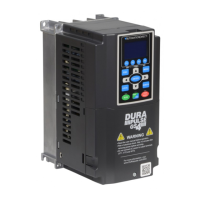Chapter 1: Getting Started
Page 1–6
DuRApulse GS4 AC Drive User Manual – 1st Ed, Rev A - 10/20/2017
seleCTing The proper drive raTing (ConTinued)
deraTe ouTpuT CurrenT based on Carrier frequenCy (if neCessary)
Carrier frequenCy effeCTs
AC Drives rectify the incoming 50 or 60Hz line power resulting in DC power at 0Hz. The resulting
DC power is then pulse-width modulated and supplied to the motor by the drive’s power
electronics. IGBTs invert the DC power, simulating a sine wave at the desired frequency (that’s
what allows variable speed in AC induction motors). The speed at which the IGBTs are turned ON
and OFF is called Carrier Frequency. In AC drives, the Carrier Frequency can range from 2kHz to
15kHz. The Carrier Frequency can be adjusted in most AC Drives.
There are trade-offs between choosing High Carrier Frequencies and Low Carrier Frequencies.
benefiTs of higher Carrier frequenCies:
•
Better efficiency (lower harmonic losses) in the motor
•
Lower audible noise
benefiTs of loWer Carrier frequenCies:
•
Better efficiency in the drive
•
Lower EMI (electrical noise)
•
Reduced reflective wave peak voltage
As a general rule, the Carrier Frequency should be set as low as possible without creating
unacceptable audible noise in the motor. Smaller systems can have higher Carrier Frequencies,
but larger drives (>20 or 30hp) should not have Carrier Frequencies set higher than 6kHz. Heavy
Duty applications typically run around 2~4kHz.

